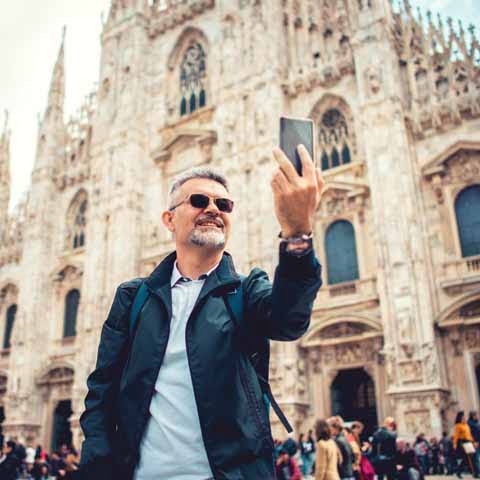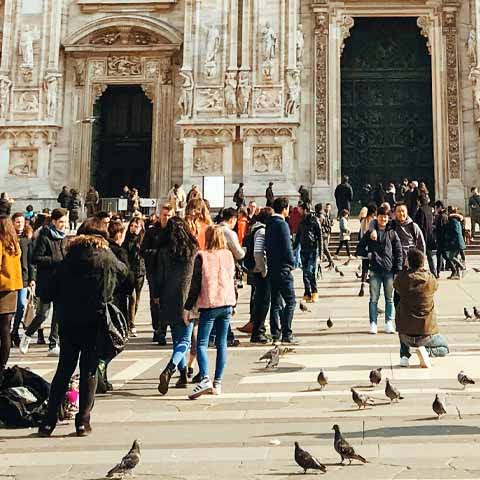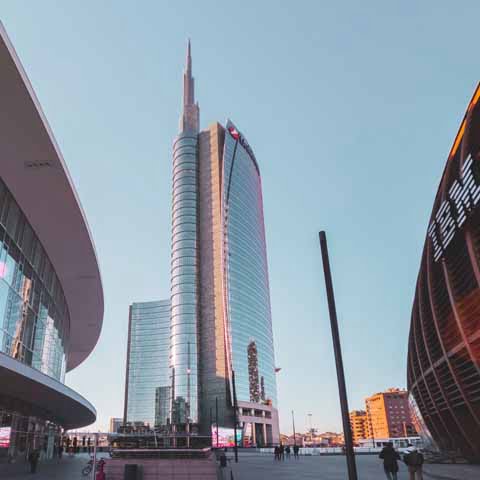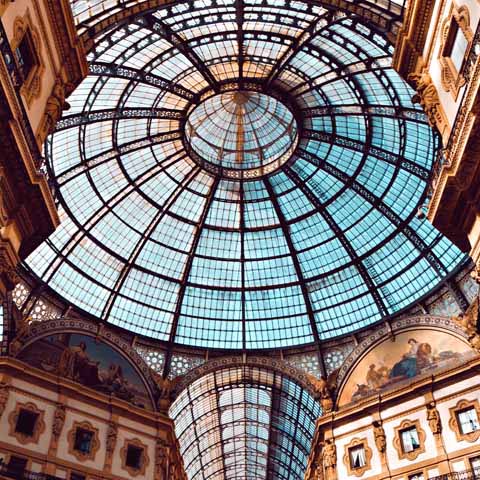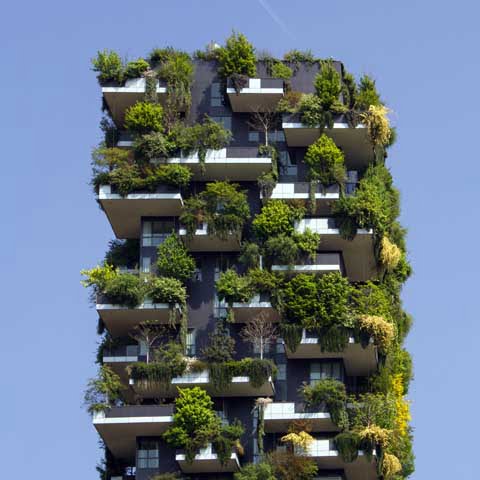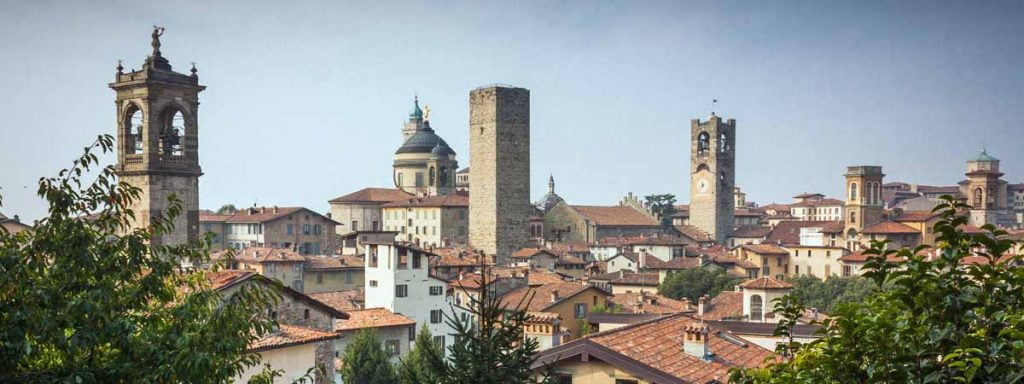Over the centuries, Milan has developed a solid industrial foundation and an economic presence in Europe that is unrivaled by other Italian cities. From its production of wool and armor during the 12th century to its major role in the production of automobiles and heavy machinery in the 19th and 20th centuries and its development as a center of international business in the 20th and 21st centuries, the city has long been a center of wealth and productivity. Despite enduring World War II bombings, Milan’s economy only improved with the continued growth of new industries and citywide construction. This ability to overcome is a continued theme for the people of Milan. The city has seen times of industry loss, yet it has utilized the opportunity in more recent years to revive portions of the city and use the strong historic framework to create new opportunities, including repurposing old factories into cultural gathering centers.
Located in the Lombardy region of Northern Italy, Milan is widely recognized as the “fashion and design capital” of the world. It is also the principal city of a vast metropolitan area, and the nearby geography has so much to offer. Surrounded by mountains, lakes, and rivers – there is something for everyone to enjoy.
Milan has the second highest population of Italy – after Rome – with over 1.4 million people calling the city home and more than 3.2 million people residing in the Milan metropolitan area. Of those residents, roughly 11% are enrolled in one of the city’s seven universities, making Milan the second most important center for higher education in Italy after Rome. The Polytechnic University, the University of Milan, Bocconi University, Università Cattolica del Sacro Cuore, and the University of Milan-Bicocca are among the universities that draw such large numbers. In addition, the city is home to more specialized institutions such as the Brera Academy of Fine Arts and the Milan Conservatory.
While the fashion scene is a major attraction for visitors of Milan, there is so much more to see and do throughout the city. Milan welcomes over 8 million travelers annually who come to explore the well-known historical architecture, art galleries, museums, and attend the opera. Many visitors want to experience Leonardo da Vinci’s famous work of art The Last Supper as well as a performance at the prestigious Teatro alla Scala, one of the most important opera houses in the world. Everyone should walk the grounds of the Piazza del Duomo and stand in awe of the beautiful architecture of the Gothic Duomo Cathedral, which is the largest church in Italy. Indoors and out, there is so much to be seen in Milan, with the benefit of enjoying the local cuisine, from risotto allo zaferrano to cotoletta alla milanese, along the way.
GEOGRAPHY & CLIMATE
The city of Milan is located in Northern Italy in the center of the Po Valley Basin. The city is surrounded by picturesque beauty with the Po River to the south and the lower foothills of the Alps to the north. Along the base of the mountains, the three lakes – Como, Maggiore, and Lugano – contribute to the northern border of Milan’s metropolitan area. The Ticino River runs along the west side and the Adda River borders on the east. The city sits at approximately 400 feet above sea level and is generally flat with some areas of marsh land.
Milan’s climate is described as continental and subtropical. Summers are hot and humid, while the winter season is cold and wet with snowfall. Spring and autumn tend to be mild with more rainfall seen in late spring. The adjacent mountain range spares the city from substantial rainfall coming from the north. Perhaps the most characteristic aspect of Milan’s weather is the blanket of fog often present in the city during the autumn and winter.
WHEN IN MILAN
A visit to Milan would not be complete without seeing the breathtaking Duomo Cathedral, located in the heart of the Piazza del Duomo in the very center of the city. The remarkable Gothic cathedral is among the largest in the world, standing at 354 feet tall and 302 feet wide. Construction of the church began in the 14th century and took almost six centuries to finish, though renovation works and upkeep will likely continue indefinitely. Once inside, travelers are hard-pressed not to fall in love with the beauty of this magnificent cathedral.
The southern side of Piazza del Duomo is dominated by the Archbishop’s Palace and the Royal Palace, which date back to the 18th century and today host interesting art exhibitions. On the opposite side of the square is the Galleria Vittorio Emanuele II, a stunning arcade that is the oldest shopping mall in Italy and nicknamed “salotto di Milano,” or Milan’s living room. Walking through the Galleria, visitors will reach Piazza Della Scala, home of Teatro alla Scala.
Northwest of the Duomo, travelers can visit one of Milan’s most popular tourist destinations: Castello Sforzesco, a 15th century castle. Not only should visitors admire the beautiful architecture, the castle also offers a number of museums focused on art, ancient artifacts, musical instruments, and historic furniture. The castle is home to Michelangelo’s last sculpture, Pietà Rondanini, and a manuscript by Leonardo da Vinci. On a sunny day, enjoy a stroll through the majestic courtyards within the castle square or Parco Sempione, a park located behind the castle.
Milan offers a number of fascinating museums including the Pinacoteca di Brera (the most important art gallery in the city), the Triennale Design Museum, Museo del Novecento (a gallery focused on 20th century art), the Leonardo da Vinci Science Museum, and many others. Among the city’s many churches, we must mention Santa Maria delle Grazie, which is home to da Vinci’s Last Supper, as well as the Basilica of Sant’Ambrogio, the Basilica of Sant’Eustorgio, the Church of San Maurizio al Monastero Maggiore, and Santa Maria in San Satiro with its amazing example of trompe-l’œil by Bramante, among many others.
To experience the city like a local, visitors can peruse the streets of the fashion district, the heart of the Milanese shopping experience. Among the most important shopping streets are Via Monte Napoleone, Via della Spiga, Via Manzoni, and Corso Venezia. Each of these streets gives eager shoppers the chance to visit the stores of luxury designers that have made Italian style famous worldwide. Do not miss the shops of Prada and Armani as both brands were founded in Milan.
CityLife is another inviting residential, commercial, and business district offering a shopping mall and a park. The symbols of the neighborhood are the three skyscrapers: Allianz Tower “il dritto” (the straight one), Generali Tower “lo storto” (the twisted one), and Libeskind Tower “il curvo” (the curved one).
To the east of CityLife, Milan’s state-of-the-art architecture and its vibrant nightlife scene converge amongst the skyscrapers of Piazza Gae Aulenti and Corso Como in the Porta Nuova district, the perfect place for gazing in awe at the “Bosco Verticale” (an innovative high-rise with an incorporated garden) and enjoying an evening with friends.
Another place to visit in the evening is the Navigli district, the other main center of Milanese nightlife and where many locals go to enjoy an “aperitivo,” pre-dinner drinks and finger foods, in good company. Composed of canals and waterways, the Navigli district truly comes alive at night.
Savor the local cuisine at one of the many restaurants located along the bustling streets. For a bit of a break from the busy city atmosphere, visitors can rent a bike and pedal along one of the popular paths – a favorite pastime of the Milanese people. After leaving Milan’s city center behind, the countryside emerges along with quaint villages and river front views.
For a day trip away from Milan, consider exploring the ancient town of Bergamo – a picturesque destination known for its upper district with medieval architecture and meaningful monuments. If time allows, stop off at Lake Como to take in the natural beauty of the water and nearby Alps.
From the Gothic spires of the Duomo to the magnificence of Leonardo’s Last Supper, the city of Milan is a worthy addition to any Italy travel itinerary. Though at first glance it may not be as picturesque as Florence or Venice, travelers who take the time to explore Milan will be rewarded with numerous artistic and cultural treasures.
Travel Guides
The Lombardy Region of Italy
The Cities of Lombardy, Italy
